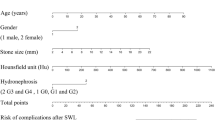Abstract
Extracorporeal shock wave lithotripsy (ESWL) is effective in the treatment of symptomatic cholecystolithiasis in well-selected patients. We analyzed the predictors of cholecystectomy in a large series of gallstone patients after ESWL. This was a retrospective follow-up cohort-study of consecutive patients undergoing ESWL for symptomatic cholecystolithiasis over a 9-year period. It was possible to analyze a total of 297 patients; there were 211 women and 86 men, with a mean age of 52 years (range, 8–81 years). Patients that had been cholecystectomized after ESWL were compared to patients with their gallbladder still in situ and determinants of cholecystemctomy in terms of clinical, stone, and gallbladder parameters and symptoms analyzed. The mean duration of follow-up was 99 months (range, 27–134 months). During follow-up, 106 (36%) patients underwent a cholecystectomy at a mean of 34 months (range, 0–127 months) after ESWL. Histological data showed a normal gallbladder wall in only 4 cases; 101 examinations revealed some kind of (chronic) inflammation, which was not different from histological gallbladder results in patients without prior lithotripsy. Three gallbladder polyps were found, but no carcinoma. Cholecystectomy after ESWL of gallbladder stones was strongly associated with persitent and/or renewed biliary symtoms. Nevertheless, only three of four patients became asymptomatic after CE. Thus, ESWL proved to be a valuable organ-preserving alternative to cholecystectomy in selected patients.
Similar content being viewed by others
References
Sackmann M, Delius M, Sauerbruch T, Holl J, Schelling G, Paumgartner G: Shock-wave lithotripsy of gallbladder stones. N Engl J Med 318:393–398, 1988
Buttmann A, Adamek HE, Weber J, Riemann JF: ESWL and oral dissolution therapy: What factors influence results? Dig Dis Sci 38:1702–1711, 1993
Sackmann M, Pauletzki J, Sauerbruch T, Holl J, Schelling G, Paumgartner G: The munich gallbladder lithotripsy study. Ann Intern Med 114:290–296, 1991
Nicholl JP, Brazier JE, Milner PC: Randomized controlled trial of cost-effectiveness of lithotripsy and open cholecystectomy as treatments for gallbladder stones. Lancet 340:801–805, 1992
Riemann JF, Adamek HE, Weber J: Piezoelectric lithotripsy in the treatment of symptomatic gallstone patients. A 12-month-follow-up. J Clin Gastroenterol 13:395–400, 1991
Adamek HE, Buttmann A, Weber J, Riemann JF: Can aspirin prevent gallstone recurrence after successful extracoporeal shock wave lithotripsy? Scand J Gastroenterol 29:355–359, 1994
Carrilho-Ribeiro L, Pinto-Correia A, Velosa J, Carneiro de Moura M: Long-term gallbladder stone recurrence and risk factors after successful lithotripsy. Eur J Gastroenterol Hepatol 12:209–215, 2000
Cesmeli E, Elewaut AE, Kerre T, de Buyzere M, Afschrift M, Elewaut A: Gallstone recurrence after successful shock wave therapy: The magnitude of the problem and predictive factors. Am J Gastroenterol 94:474–479, 1999
Pauletzki J, Althaus R, Holl J, et al.: Gallbladder emptying and gallstone formation: A prospective study on gallstone recurrence. Gastroenterology 111:765–771, 1996
Schneider HT, Benninger J, Rabes U, et al.: Recurrent gallstone formation after successful extracorporeal shock wave lithotripsy. Am J Gastroenterol 88:1399–1403, 1993
Stölzel U, Koszka C, Wölfer B: Relief of heterogenous symptoms after successful gall bladder stone lithotripsy and complete stone disappearance. Gut 35:819–821, 1994
Tazuma S, Nishioka T, Ochi H, et al.: Impaired gallbladder mucosal function in aged gallstone patients suppresses gallstone recurrence after successful extracorporeal shock wave lithotripsy. J Gastroenterol Hepatol 18:157–161, 2003
Wehrmann T, Marek S, Hanisch E, Lembcke B, Caspary WF: Causes and management of recurrent biliary pain after successful nonoperative gallstone treatment. Am J Gastroenterol 92:132–138, 1997
Janssen J, Johanns W, Weickert U, Rahmatian M, Greiner L: Long-term results after successful extracorporeal gallstone lithotripsy: Outcome of the first 120 stone-free patients. Scand J Gastroenterol 36:314–317, 2001
Adamek HE, Sorg S, Bachor OA, Riemann JF: Symptoms of post-extracorporeal shock wave lithotripsy: Long-term analysis of gallstone patients before and after successful shock wave lithotripsy. Am J Gastroenterol 90:1125–1129, 1995
O’Donnell LD, Heaton KW: Recurrence and re-recurrence of gallstones after medical dissolution: A long-term follow-up. Gut 29:655–658, 1988
Miyoshi H, Hattori T, Kou K: Long-term outcome after extracorporeal shock wave lithotripsy for gallstones. Jap J Gastroenterol 98:1349–1356, 2001
Tomida S, Abei M, Yamaguchi T: Long-term ursodeoxycholic acid therapy is associated with reduced risk of biliary pain and acute cholecystitis in patients with gallbladder stones: A cohort analysis. Hepatology 30:6–13, 1999
Ochi H, Tazuma S, Kajihara T: Factors affecting gallstone recurrence after successful extracoporeal shock wave lithotripsy. J Clin Gastroenterol 31:230–232, 2000
Sackmann M, Niller H, Klueppelberg U, et al.: Gallstone recurrence after shock-wave therapy. Gastroenterology 106:225–230, 2000
Schreiber F, Steindorfer P, Pristautz H, Gurakuqi GC, Schnedl W, Trauner M: Complications and surgical interverntions during 4 years of biliary extracorporeal shockwave lithotripsy. Hepatogastroenterology 31:1124–1128, 1996
Ahmed R, Freeman JV, Ross B: Long term response to gallstone treatment—Problems and surprises. Eur J Surg 166:447–454, 2000
Plaisier PW, van der Hul RL, Nus HGT, den Toom R: The course of biliary and gastrointestinal symptoms after treatment of uncomplicated symptomatic gallstones: Results of a randomised study comparing extracorporeal shock wave lithotripsy with conventional cholecystectomy. Am J Gastroenterol 89:739–744, 1994
Carrilho-Ribeiro L, Serra D, Pinto-Correia A, et al.: Quality of life after cholecystectomy and after successful lithotripsy for gallbladder stones: A matched-pairs comparison. Eur J Gastroenterol Hepatol 14:741–744, 2002
Frick T, Cercic P, Hoffmann R, et al.: Gallbladder morphology after extracorporeal shock wave lithotripsy of gallstones with the MPL-9000. Helv Chir Acta 58:149–152, 1991.
Author information
Authors and Affiliations
Corresponding author
Rights and permissions
About this article
Cite this article
Adamek, H.E., Rochlitz, C., Von Bubnoff, A.C. et al. Predictions and Associations of Cholecystectomy in Patients with Cholecystolithiasis treated with Extracorporeal Shock Wave Lithotripsy. Dig Dis Sci 49, 1938–1942 (2004). https://doi.org/10.1007/s10620-004-9596-x
Published:
Issue Date:
DOI: https://doi.org/10.1007/s10620-004-9596-x




